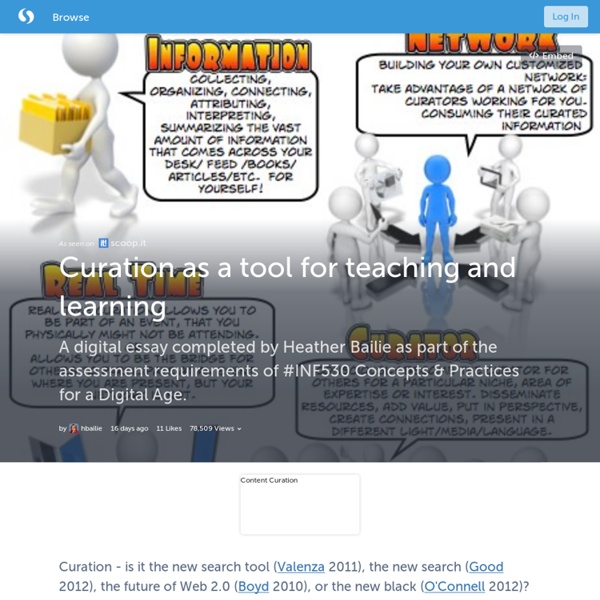Content curation
Content curation is the process of selecting, sorting and arranging content on a specific topic or theme, adding value and meaning to what has been curated for your users. Contents Defining content curationWhy curate contentPartnerships in curating contentWho can benefit from curated contentFurther reading Defining content curation
1.1 Introduction to OER - Open Educational Resources
The development of materials by instructors is an important step in learning and teaching. Good learning resources help students develop an understanding of concepts, ideas, and order of operations. With connectivity and collaboration at the fingertips of everyone with internet access, the idea of shared resources is the basis of the OER movement. With digital licenses to accompany copyright allowing for the usage, repurposing and sharing of learning resources, the network of content developers can become limitless.
Why is Digital Curation so Important for Educators in 2018?
Image Source I’ve been working with schools, colleges and universities for nearly 8 years. Working to promote entrepreneurship and digital skills to make young people more employable and teach them how to innovate. Digital research is becoming increasingly important and educators and students need to know how to curate it.
OER Issues: Apples, Orchards and Infrastructure
Open Education Resource (OER) advocates are gathered this week in Vancouver for the 12th annual Open Education conference. Reflecting their energy and their evangelism, the home page of the conference web site proclaims “Open Education resources provide a massive, high quality open content infrastructure on top of which innovative people and organizations are building a new generation of educational models. Methodologically rigorous research is demonstrating that these OER-based models can be extremely effective in reducing the cost of education and improving student learning.” Clearly the OER movement is fueled by good intentions and great aspirations. Several reports and events leading into this week’s Open Ed conference may help to advance the OER cause. The JCHE article is worth reading.
Why Curation Revolutionizes Education & Learning — Content Curation Official Guide
Why Curation Revolutionizes Education & Learning 10 Disruptive Factors Transforming the World of Education and Learning — Consequences, Opportunities, Tools “It is the best of times. It is the worst of times.
Scientists Are Putting Tens of Thousands of Sea Fossils Online
Published on Written by Erin Blakemore Some 100 million years ago, much of what is now North America was underwater. The body of water scientists calls the Western Interior Seaway covered a swath of land that stretched over the entire Midwest. But its secrets have been preserved in countless fossils—and now, over 100,000 of these fossils are being digitized.
Curation
Learning is the process of acquiring knowledge, which is an active process and operates at both individual and social levels. When it comes to information behaviour within this context there are a wide range of theories and models which represent thinking and research investigations in this field. Existing models have elements in common, though most models in library and information science focus on information seeking and the information user, while those from the field of communications focus on the communicator and the communication process.
CC Open Education Platform - CC Global Network
What is the Open Education Platform? The Creative Commons Open Education Platform is a space for open education advocates and practitioners to identify, plan and coordinate multi-national open education content, practices and policy activities to foster better sharing of knowledge. This platform is open to all interested people working in open education. We work in a transparent, professional, ethical and public manner on the following goals: 1. Build and Sustain Community
Curation: Beyond the Buzzword - Additional Resources
On May 11th, I had the privilege of leading a session for the Council for Learning and Leadership Development of the Conference Board of Canada titled Curation: Beyond the Buzzword. This blog post is being set up a follow-up resource for those that attended the session. It may also serve as a resource for anyone that wants to learn more about curation and learning.
Distance Learning and The Physics Classroom
The Physics Classroom and Distance Learning We've had a phrase in our heads for a long time that sums up our mission: "serving students, teachers and classrooms." Every resource on our website has been fueled by the passion to put a tool in the hands of a student or a teacher to help them more effectively learn or teach physics. During this COVID19 pandemic, The Physics Classroom has numerous tools to address the distance learning needs of students, teachers, and "classrooms". We believe that the resources described below will be your best resources during this transition from classroom teaching to distance learning. Version 2 Concept Builders
Pinterest, Tumblr and the Trouble With ‘Curation’
I’m not a big Pinterest user (more of a lurker, really), but the over-the-top monetary valuation doesn’t entirely surprise me. Long before I heard of Pinterest, I was already spending too much time on “curated” (read: reblogged) design/fashion/image/inspiration blogs. For me, it’s sites like Apartment Therapy, Ffffound, Poppytalk, Oh Joy and dozens and dozens of obscure, exquisite, utterly pointless but oddly compelling Tumblrs.
Learning objects - e-Learning kit - Guides at McGill Library
Wiley defines learning objects as "any digital resource that can be reused to support learning" (2000, p7). With that in mind, you will find tools for creating videos, podcasts, graphics, presentations, timelines, and e-books. Learning object repositories/databases PRIMO (Peer-Reviewed Instructional Materials Online Database) LIONTV: Library Information Literacy Online Network from Animated Tutorial Sharing Project (ANTS) S.O.S. for Information Literacy Merlot (California State University System) OER Commons ASU for You: Publicly accessible digital Repository learning materials CORA (Community of Online Research Assignments) Videos
Open Learning Network
The College of Earth and Mineral Sciences' OER initiative



